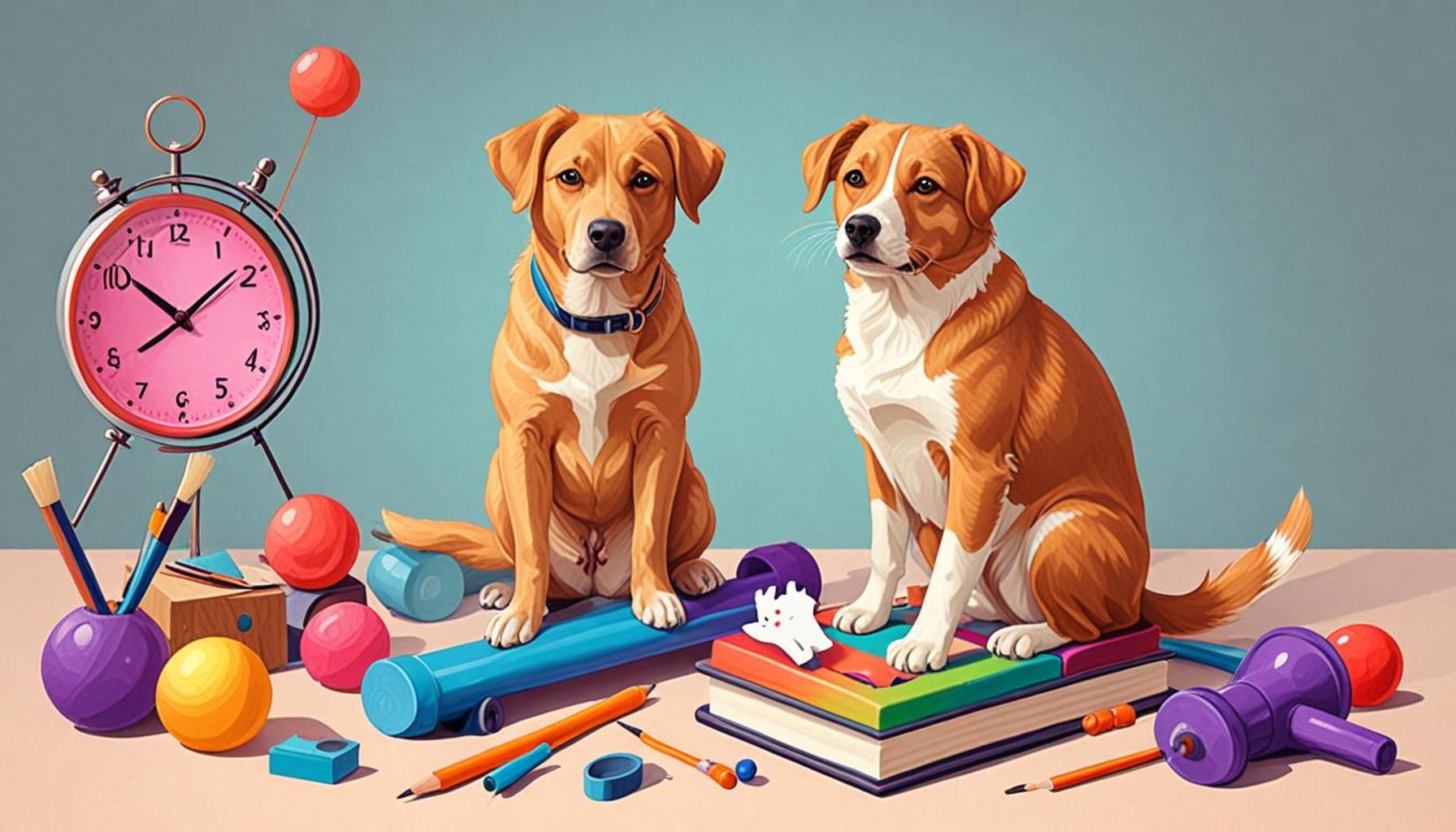Understanding the Importance of Consistency in Training Techniques: Creating a Routine for Your Pet

The Importance of Consistent Training in Pet Development
Establishing a training routine for your pet is crucial for their development and well-being. Consistency in training techniques not only builds trust but also reinforces positive behavior. By skillfully implementing a structured routine, pet owners can expect to witness improvements that are both effective and long-lasting. This prevents the frustration often associated with inconsistent behavior and promotes a harmonious living environment for both pets and their human companions.
Consider the following key aspects of maintaining consistency in pet training:
- Repetition: Regular practice helps your pet understand commands more thoroughly. For instance, repeated reinforcement of commands such as “sit,” “stay,” or “come” in short, focused sessions enables your pet to assimilate these behaviors effectively. Over time, this can lead to your dog or cat responding instinctively without hesitation.
- Timing: Consistent timing in rewards and corrections enhances learning. Dogs, for example, learn best when they are immediately rewarded with treats or praise right after a desired action, meaning that timing is critical. A delay can confuse them about what behavior is being reinforced, which can impede their training progress.
- Environment: Training in varied but controlled settings aids in generalizing behaviors. For example, practicing commands in different locations—such as indoors, at a local park, or even amidst the distractions of a busy street—can help solidify your pet’s ability to respond to commands regardless of surroundings.
Incorporating training into your pet’s daily routine not only enhances their learning capacity but also caters to their innate need for structure. Pets, much like children, thrive on routines and predictability, which can alleviate anxiety and foster confidence. A predictable routine not only enriches the training process but also lays the groundwork for a deeper bond between you and your furry friend. This emotional connection is crucial, as it allows for more meaningful interactions and a healthier relationship.
Moreover, a consistent training regimen can significantly ease common behavioral challenges, from housebreaking puppies to managing the antics of mischievous kittens. When training becomes a natural part of daily life, showing your pet what behaviors are desirable becomes easier and more effective. A well-trained pet is often a happier pet, showcasing reduced behavioral issues and stress.
In this article, we will explore the elements that contribute to effective training routines, why consistency is essential, and practical tips for developing a successful regimen tailored to your pet’s needs. By the end, you will have more than just tips; you will understand the profound importance of a structured approach to pet training, and how it impacts your beloved companion in meaningful ways.

LEARN MORE: Click here for insights
Creating a Structured Training Routine
Establishing a structured training routine is not merely about teaching your pet commands; it is fundamentally about laying down the groundwork for a reliable and trusting relationship. When pet owners prioritize consistency in training techniques, they open the door to a world where positive behavior is attainable and sustainable. But how do you develop this structured routine effectively?
To start, it’s essential to identify specific goals for your pet’s training. These goals could range from basic commands like “sit” and “stay” to more complex behaviors such as leash walking or socializing with other pets. Having clear objectives allows you to tailor the training sessions to address the unique needs of your pet, ensuring that each practice session is purposeful and engaging.
Next, consider the development of a training schedule. Just like humans benefit from regular physical activities, pets thrive with a consistent routine. Here are some fundamental components to include when creating that schedule:
- Frequency: Aim for short training sessions several times a day instead of a lengthy session once a week. For example, five to ten minutes of practice after meals can be both effective and enjoyable for your pet.
- Time of Day: Incorporate training during times that work best for your pet’s energy levels. If your dog is most playful in the morning, that’s the ideal time for a training session.
- Positive Reinforcement: During each training encounter, use a reward system that reinforces desired behaviors. This could be in the form of treats, toys, or verbal praise, which strengthens the bond between you and your pet.
Furthermore, consistency also means involving all family members in the training process. This ensures that commands and expectations are uniform, which can help in reducing confusion for your pet. Assigning roles or having universal cues can be pivotal, especially in households with multiple individuals handling the pet’s care and training. When everyone is on the same page, the overall effectiveness of the training is significantly enhanced.
Moreover, consistency in tone and approach is crucial. Many pet trainers emphasize that a calm and assertive demeanor can deeply influence how a pet responds. Pets are sensitive to human emotions; therefore, maintaining a positive yet firm approach can lead to better outcomes. Remember, training is not only about instructing your pet but also about fostering an environment where they feel safe and secure while learning.
In conclusion, creating a structured training routine centered on consistency is not just important; it is essential for your pet’s success and overall happiness. As we delve deeper into this article, we will explore additional techniques and practical examples tailored to various types of pets, enabling you to craft the ideal training regimen suited to your furry companions.
When developing a training routine for your pet, the importance of consistency cannot be overstated. Implementing a structured approach not only aids in the learning process but also strengthens the bond between you and your pet. Consistent training techniques lead to improved behavior, as pets thrive on routine and predictability. For instance, using the same commands for actions such as sitting or staying assures your pet understands what is expected of them. Repetition is a key element; just like humans, pets learn best through practice. By maintaining a regular training schedule, you establish a pattern that your pet can rely on.Moreover, consistency builds trust. Pets who know what to expect feel more secure and less anxious. This is especially important for young or rescue animals who may come with a troubled past. Changing your methods or being inconsistent can lead to confusion and frustration. In such cases, clear communication and consistent reinforcement of positive behaviors will lead to a better-trained, happier pet.In essence, creating a routine that integrates consistent techniques ensures that your pet not only learns desired behaviors more effectively but also experiences a fulfilling and enjoyable training journey. Different pets may respond to different approaches, which is why understanding your pet’s specific needs and preferences is crucial. Tailoring your methodology while remaining consistent can lead to remarkable progress, allowing your pet to thrive and become a cherished member of your household. Exploring further, incorporating variety into your routine—such as different activities and environments for training—can also enhance your pet’s adaptability and promote cognitive stimulation while still adhering to consistent commands and practices. It creates a balanced approach to training that keeps things engaging and fun for both of you.
DISCOVER MORE: Click here to learn about effective socialization techniques for your puppy
The Role of Socialization in Consistent Training
While establishing a structured training routine is imperative, another crucial aspect to consider is the role of socialization in your pet’s training journey. Socialization involves exposing your pet to various environments, people, and other animals in a positive, controlled manner. This exposure forms an essential part of their development, helping to reduce fear and anxiety, which can impede training progress. A well-socialized pet is often more adaptable and responsive, making consistency even more critical in these instances.
To initiate socialization, consider incorporating regular outings into your training schedule. Visiting parks, pet-friendly stores, or even attending community events can provide invaluable experiences for your pet. Be sure to keep training commands consistent in these varying environments. This approach reinforces expectations despite distractions, teaching your pet to stay focused on you, regardless of external stimuli. Over time, consistent practice in diverse settings will enhance their confidence and responsiveness to commands.
Utilizing Consistency Across Training Techniques
Another key element of consistency is the application of various training techniques. Many pet owners often feel overwhelmed by the plethora of training methodologies available, from positive reinforcement to clicker training. However, it’s essential to choose a technique that aligns with both your training goals and your pet’s personality. Whatever method you select, ensure that you apply it uniformly to foster a clear understanding of desired behaviors.
For instance, if you opt for positive reinforcement, always reward your pet with treats or praise immediately following a behavior you want to encourage. If your pet demonstrates a behavior consistently, gradually phase out the treats and rely on verbal praise. This practice teaches your pet to respond to commands without becoming overly reliant on food rewards, affirming their ability to connect actions and results. Maintaining consistency in your rewards reaffirms your expectations.
Incorporating Flexibility within Consistent Frameworks
While consistency is key, it’s also essential to incorporate a degree of flexibility within your training routine. Each pet is unique, and as they progress, you may need to adapt your approaches to their evolving needs. This adaptability can prevent frustration for both you and your pet if any particular technique seems to be losing effectiveness. Monitor your pet’s behavior and remain open to modifying your methods while maintaining the core principles of consistency.
Moreover, introducing varied activities and challenges can keep your training sessions engaging. For instance, after mastering basic commands, you might consider introducing agility drills or puzzle-solving games that stimulate your pet both physically and mentally. Such diversity not only enhances learning but also strengthens the bond between you and your pet. Surrounding these challenges with consistent cues, rewards, and expectations will facilitate a well-rounded training approach.
Finally, it’s essential to understand the overall well-being of your pet contributes to their ability to learn and absorb training. A physically and mentally healthy pet is more receptive to learning. Ensure your pet gets adequate exercise and mental stimulation, as fatigue can hinder their focus during training sessions. Remember, a well-balanced routine taps into the full spectrum of learning, allowing for a truly comprehensive understanding of consistency in your training techniques.
DIVE DEEPER: Click here to learn about the benefits of proper nutrition for your pet’s health
Conclusion: The Path to Successful Pet Training
In the journey of pet training, consistency serves as the backbone of effective practice. By establishing a structured routine, not only do you lay the groundwork for your pet to learn commands and behaviors effectively, but you also create a nurturing environment that fosters their development. Yet, training extends beyond mere repetition; it encompasses a comprehensive understanding of your pet’s unique needs, personality, and social dynamics. This multifaceted approach allows for an adaptive routine that remains engaging and beneficial for both you and your pet.
Moreover, the importance of socialization cannot be overstated. Regular exposure to different environments, people, and situations enhances your pet’s adaptability and responsiveness, reinforcing the principles established in their training. A well-socialized pet becomes not only more confident but also more attuned to your commands amidst various distractions. Thus, maintaining consistency in training techniques across diverse settings further cements their understanding.
Flexibility within a consistent framework is equally essential. Recognizing when to adjust your methods not only addresses challenges but also prevents frustration and keeps motivation alive. By varying activities and keeping sessions engaging, you can nurture a robust learning environment that ultimately strengthens the bond between you and your pet.
Remember, a well-rounded training routine isn’t just about achieving obedience; it’s about nurturing a thriving partnership. By emulating consistency, investing in socialization, and remaining adaptable, you pave the way for a rewarding training experience. As you embark on this journey with your pet, harness the power of consistency to unlock their full potential and create a harmonious coexistence that brings joy to your life together.


